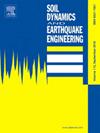A framework to integrate conditional simulation of multicomponent spatially varying ground motion field with seismic performance assessment and its application to medium-span bridges
IF 4.2
2区 工程技术
Q1 ENGINEERING, GEOLOGICAL
引用次数: 0
Abstract
The routine practice of seismic design and performance assessment employs three translational components of ground motion, but their spatial variability is rarely considered. A comprehensive framework that integrates the conditional simulation of multicomponent (three translational and three rotational) spatially varying ground motion field (accounting for the site-specific epistemic uncertainties) with the seismic performance assessment of a structure is not yet explored in the prior art. Along the same line, this paper is aimed to develop such a comprehensive framework and demonstrating its application to a medium-span reinforced concrete highway bridge. This is to offer dual objectives: i) understanding the influence of Spatially varying ground motion (SVGM) field on different engineering demand parameters (EDPs); and ii) influence of multicomponent excitation on the EDPs. Two types of bridges, namely, one simply supported and one 4-span continuous, are considered for this purpose. Probabilistic seismic hazard assessment (PSHA) employing the logic tree approach is carried out for selection and scaling of translational ground motion components. Conditional simulation of SVGM field for translational components is carried out using an evolutionary power spectral density-based framework accounting for the coherency and site-specific effects. Subsequently, the rotational components at each station are extracted using a single-station procedure. Nonlinear time history analysis of the bridge is carried out while considering various combinations of translational and rotational components of ground motion, and the results from SVGM field are compared with that computed using spatially uniform ground motion (SUGM). Overall, the nature and extent of influence contributed from the consideration of multicomponent SVGM field is contingent to the EDPs of interest as well as the structural configuration. The demand for a given EDP when subjected to SVGM field may either be amplified or deamplified depending on the structural configuration.
求助全文
约1分钟内获得全文
求助全文
来源期刊

Soil Dynamics and Earthquake Engineering
工程技术-地球科学综合
CiteScore
7.50
自引率
15.00%
发文量
446
审稿时长
8 months
期刊介绍:
The journal aims to encourage and enhance the role of mechanics and other disciplines as they relate to earthquake engineering by providing opportunities for the publication of the work of applied mathematicians, engineers and other applied scientists involved in solving problems closely related to the field of earthquake engineering and geotechnical earthquake engineering.
Emphasis is placed on new concepts and techniques, but case histories will also be published if they enhance the presentation and understanding of new technical concepts.
 求助内容:
求助内容: 应助结果提醒方式:
应助结果提醒方式:


